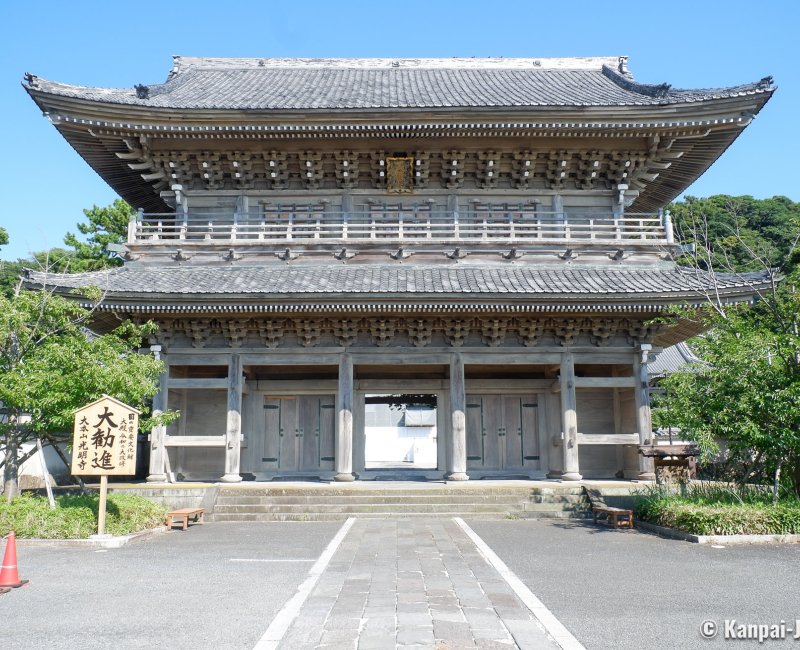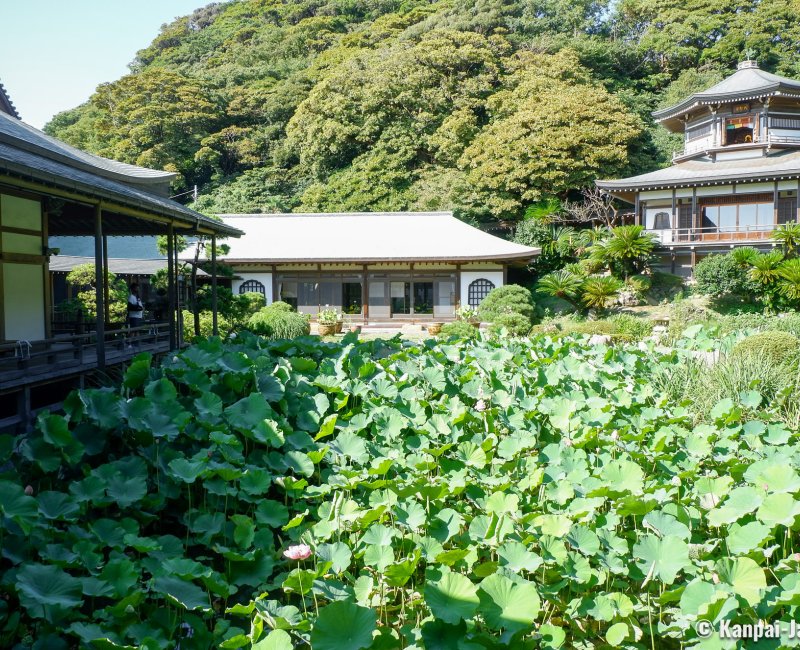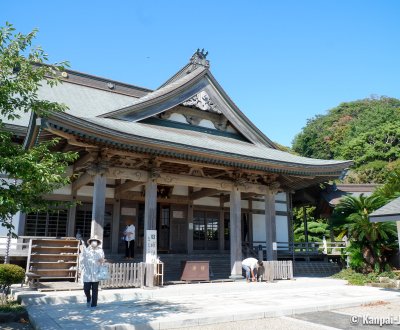Komyo-ji
🪷 The Ancient Lotus Temple in Kamakura
Komyo-ji is a Buddhist temple of the Jodo-shu sect located near the beaches at the south-eastern end of Kamakura City in Kanagawa prefecture. While not popular among tourists, its historical background and its pavilions’ impressive architecture make the site worth the discovery.
Various pavilions of the temple, including the main hall, are under renovation until 2028. These works aim at celebrating the 850th anniversary of the founding of the Jodo sect.
Komyo-ji was built in 1243 on the shogunate’s order, then ruled by Hojo Tsunetoki (1224 - 1246) when Kamakura was still the capital of Japan (1185 – 1333). The temple was founded by Ryochu Shonin (1199 - 1287), the 3rd head of the Jodo-shu sect, the "Pure Land School" of Buddhism that Honen (1133 - 1212) had initiated in 1175.
The former capital’s seaside entrance
Facing the Sagami Bay, the temple is located close to the city’s former port which was an important hub during the Kamakura period. Nowadays, the only remains of the vanished harbor is a gravel embankment surfacing the water and called Wakae-jima. Komyo-ji was therefore conveniently located to attract the disembarking merchants and sailors.
At the end of the 15th century, emperor of Japan Go-Tsuchimikado (1442 - 1500) raised the Komyo-ji to the rank of imperial temple (勅願寺 chokuganji), that is to say to the same level as the influential Todai-ji and Yakushi-ji temples in Nara. Later, during the Edo period (1603 – 1868), the powerful Tokugawa clan deemed it Kanto’s main temple for the teachings of the Nenbutsu, an ascetic practice consisting of invoking the name of Buddha Amida.
Despite its rich past, Komyo-ji is not very popular among tourists who prefer temples that are closest to the stations such as Hase-dera, Kotoku-in or Kencho-ji. Thanks to its closeness to Zaimokuza Beach 🏖, a seaside spot in summer, it is basking in the sea spray and offers a beautiful view on the ocean from the upper balcony of the Sanmon gate, that it is usually possible to visit.

A typical Zen temple configuration
Komyo-ji’s spiritual grounds is arranged in a traditional fashion with a succession of buildings with very specific roles. The visit naturally starts at the gates:
- Somon (総門), renovated between 1624 and 1628, with an access to the parking; and,
- Sanmon (山門), a majestic 2-stories wooden gate (二重門 niju-mon) built in 1847. Its over-sized dimensions: 20 meters high per 16 meters width and 7 meters depth, make it one of the largest Buddhist gates in the area.
Then, the main courtyard, where several sakura 🌸 cherry trees are growing, serves all the pavilions, especially:
- The Tower Bell Shoro (鐘楼) built in Zelkova wood during the Edo period, it shelters a 1,125kg bell (the largest in Kamakura);
- Daiden (大殿), the main building of the temple, located at the back when walking straight from the Sanmon gate. It was reconstructed in 1698 and currently under renovation until 2028 (and consequently closed to the public). To this day, it is still the city’s largest temple pavilion. One can catch a glimpse of the stone garden called Sekitei (石庭) when visiting the inside.
- On its left, the Kaisando (開山堂) is the temporary main hall sheltering the main representations of Buddha during the Daiden’s renovation. Built in 1924, the pavilion is dedicated to the founder monk Ryochu Shonin.
Wooden paths lead to the inner part of the temple dedicated to the Kishu Teien (記主庭園) garden which is a representation of the "Pure Land" where the Buddha Amida lives. Its a beautiful pond is covered in ancient lotus 🪷, called Kodai-Hasu, that are said to have sprouted from seeds buried during prehistoric times, about 2,000 years ago. The pond is overlooked by the beautiful octagonal pavilion Daishokaku (大聖閣), standing on a hill covered with a lush vegetation and celebrating the 800th anniversary of Ryochu Shonin. A gilded statue of Amida can be sighted through the window of its 2nd floor. The landscape, both mystical and natural, offers an immersion in a complete Zen serenity, and it is recommended to rest on the benches to enjoy it a little bit longer.

The neighboring cemetery is also home to Ryochu Shonin’s grave, a mausoleum dedicated to the Naito clan (important lords of the Edo period), and a more contemporary space dedicated to pets.
Shojin ryori, the monks’ cuisine
All visitors have the possibility to have lunch at the temple, which is still a rare experience in Japan. Upon prior reservation, one can chose a typical Buddhist menu, called shojin ryori, that follows the monks’ strict diet rules. Therefore, the food does not contain any ingredient produced from animal exploitation and the meal can be labeled vegan.
Very surprising with different tastes and textures, the monks’ lunch is a privileged and timeless moment. If it is too hard to sit on the floor, you can also eat sitting on a chair.
Komyo-ji offers a very enjoyable visit, slightly off the city center and with very few people as it is rarely mentioned in sightseeing guides. One can therefore thoroughly enjoy the temple’s grandiose gardens and architecture.

